Thursday 7th September 2023
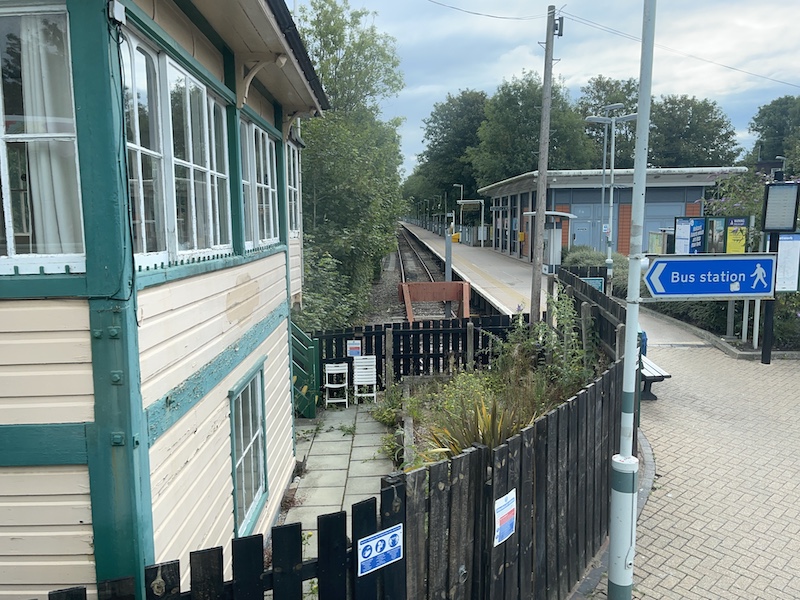
We must keep investing in our railway infrastructure to stand a chance of meeting net zero targets. Motorists aren’t going to be persuaded to leave the car at home if rail isn’t offering capacity and convenience and an effective alternative to driving.
Despite the Governments recently reported ‘cold feet’ over actively pursuing the ‘green agenda’ there are some significant rail projects recently completed (Crossrail) or underway: HS2 being the obvious example (aside from its ‘paused’ Euston) along with East-West Rail and the TransPennine Route Upgrade while the DfT’s Restoring Your Railway projects are also very welcome to see (eg Okehampton re-opened and the Ashington line well underway in Northumberland) as well as numerous station re-openings (seven this year alone in England and many more in progress) with Scotland’s railways also continually expanding (Levenmouth currently under construction)… so why is it that reinstating seven miles of track between Uckfield and Lewes never seems to hit the mark?
I was recently contacted by Brian Abbott from the Wealden Line Campaign drawing my attention to the Group’s continual lobbying to restore this missing rail link and inviting me to write about it.
Without any doubt, along with the missing link between Skipton and Colne, they’re the two most tenacious campaign groups who, in the face of coming up against so many closed doors, nevertheless doggedly keep going to raise awareness of their causes. You have to admire their determination.
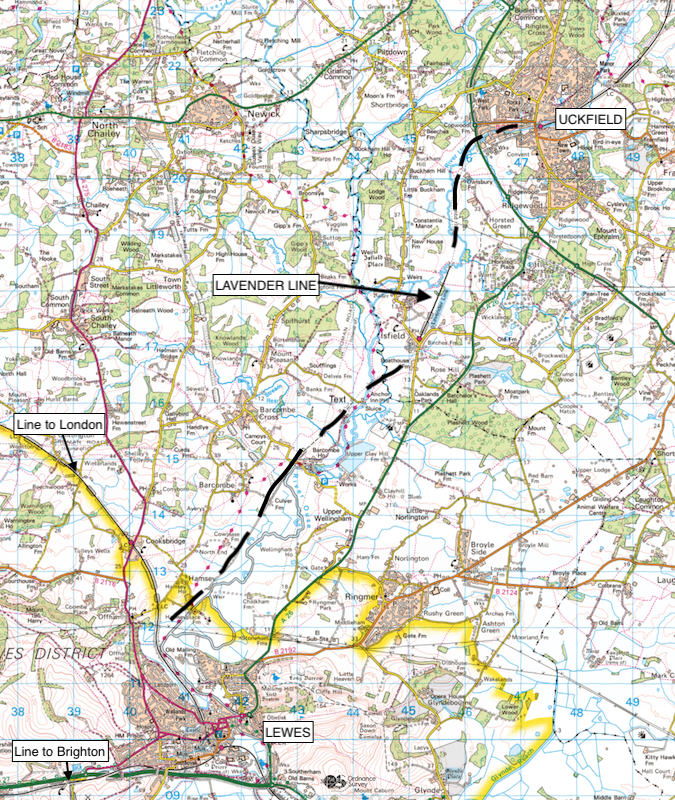
Neither Uckfield-Lewes or Skipton-Colne feature in the DfT’s current short list of projects that are in receipt of funding for business case evaluation so nothing is going to happen any time soon, or longer term, but the case they put forward is never short of passion and logic, it’s just the finances that always seem to be the problem although when you see the way costs are going on HS2 it does make you wonder whether adding Uckfield – Lewes on to that mushrooming bill would hardly be noticed.
The Wealden Line Campaign is well used to disappointments and coming up against closed doors. Over the years they’ve been given many positive noises and commitments from Ministers – the Group’s website provides a litany of supportive statements from Secretaries of States, Chancellor of the Exchequers and others – but nothing ever comes of them.
A full on study undertaken by Network Rail in 2008 concluded whilst restoring the link would be a nice to have and was technically feasible there was no economic case for it.
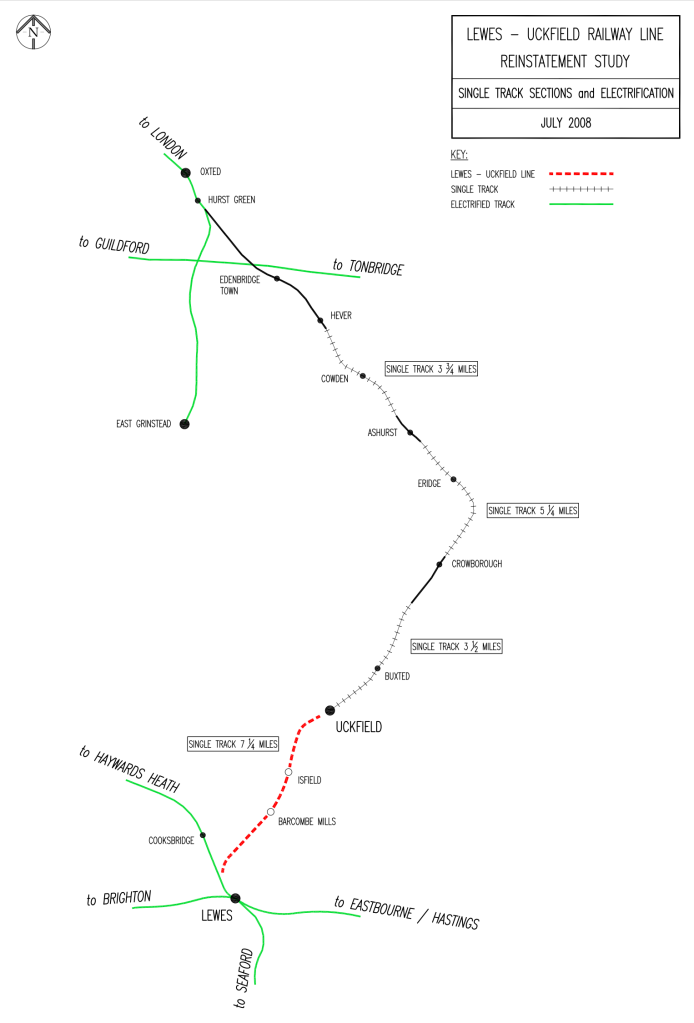
But the counter point from the campaign group was the study was far too narrow in its focus merely looking at benefits of connecting Lewes with Uckfield as well as improvements to connectivity within East Sussex whereas the Group argue seven miles of restored track could offer far more strategic benefits, not least an alternative route between Brighton and London to the main line via Gatwick Airport.
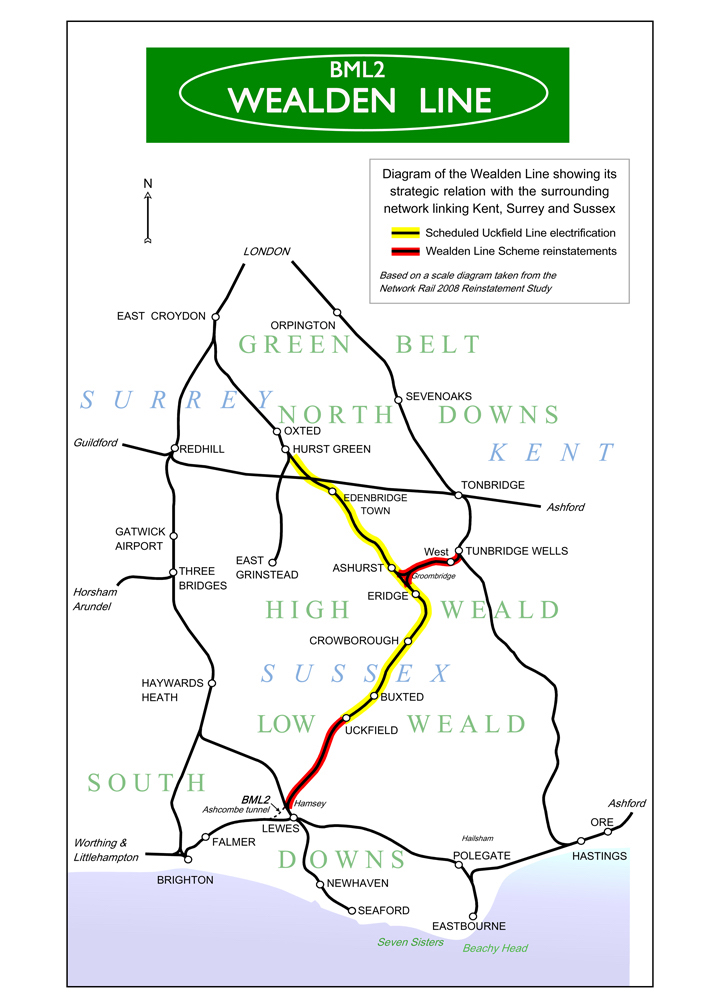
That’s why in 2010 the Wealden Line Campaign launched BML2, suggesting restoring the missing seven miles of track would create a second Brighton Main Line. To overcome the problem of trains arriving into Lewes facing the “wrong way” before continuing to Brighton, the Group suggest a new section of two-and-a-half miles of track including a one-and-a-half miles long tunnel under the South Downs at Ashcombe to connect to the Coastway East line east of Falmer, which would also provide improved connections to Brighton & Hove Albion’s Amex Stadium (opened in 2011 after the aforementioned 2008 study) and both Sussex University and Brighton University campuses located there.
To complete the picture the Group also envisages taking over the line currently used by the Spa Valley Railway between Tunbridge Wells West and Eridge and provide a new connection northwards so trains could access the line towards Edenbridge from Tunbridge Wells and vice versa.
Even more ambitious is the idea of building a new line from East Croydon through another new tunnel to connect with Canary Wharf and Stratford in what is called the “London Phase” of the BML2 project but comes from a privately funded consortium known as the London & Southern Counties Railways.

To me, this proposal looks like a coloured line on a map too many, but I don’t doubt the sincerity of those proposing it.
Meanwhile, back to the seven miles of missing track in East Sussex, Transport for the South East (TfSE) published its 30 year Transport Strategy in 2020 and addressing four challenges it lists for Inter-urban journeys in the Region it includes the solution to “deliver better inter-urban rail connectivity such as direct rail services from Brighton/Lewes to Uckfield.”
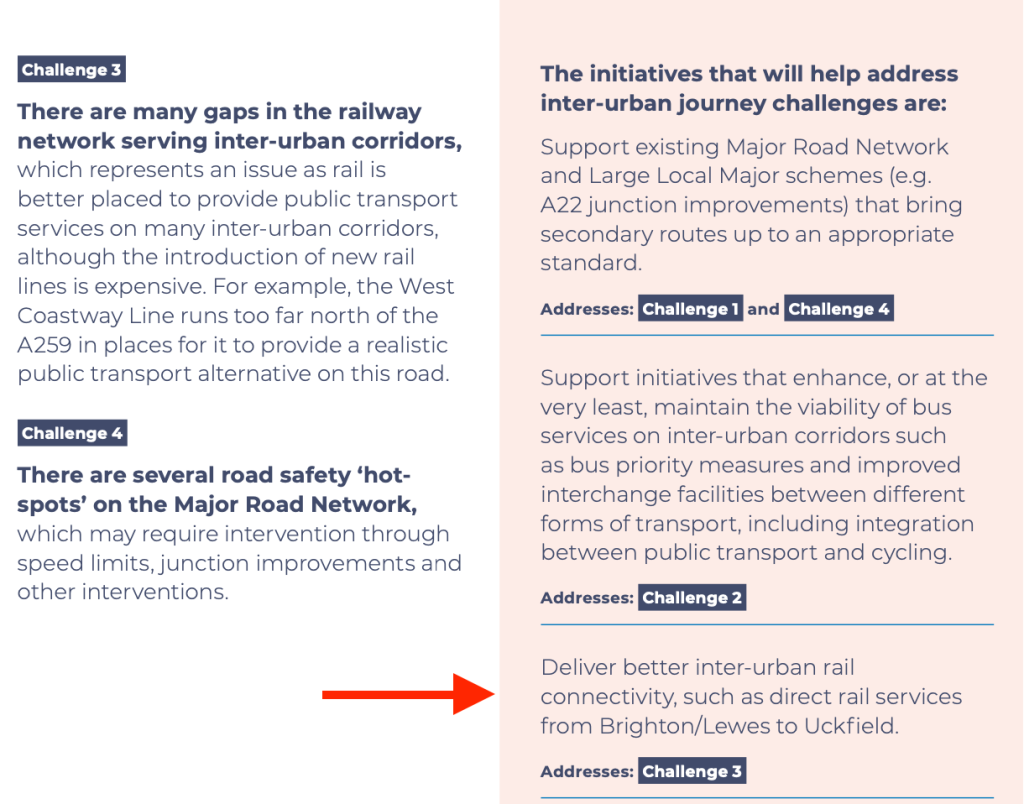
TfSE has no delegated powers so the DfT is not committed to the strategy’s contents but including reference to Lewes-Uckfield as well as commensurate electrification between Uckfield and Hurst Green has given the Group renewed hope. TfSE submitted its Strategic Investment Plan to the DfT for approval in July. The Wealden Line Group’s latest newsletter notes this Plan also contains “a colossal and controversial package of new road projects running into billions of pounds, whilst the infinitely more valuable and appropriate rail schemes pale by comparison. This is an unsustainable position – as unsustainable as believing we can simply carry on building more and more roads – and just as delusional as the 1950-60s when governments thought everyone owning cars was the solution.”
When Brian contacted me I asked him to let me have an idea of how much it would cost to reinstate the seven miles of track. He pointed me to the 2008 Network Rail study which at that time came up with a total estimated cost (including 30% contingency) of £143.3 million with a further £39.9 million for a double track option.

The former works out at £11.9m per kilometre which Network Rail points out in a cost comparison table in its report is cheaper than the A27 Beddingham to Southeram improvement scheme and in the same ballpark as the reopening of the Airdrie to Bathgate line in Scotland.
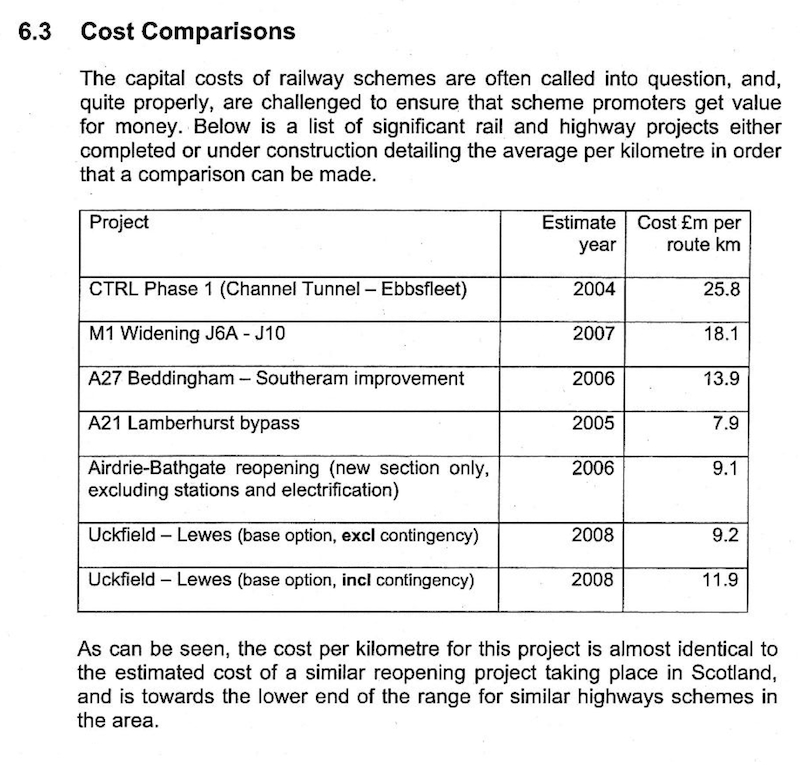
However, the cost estimate didn’t include the Campaign Group’s proposed new line through a tunnel at Ashcombe to reach the Coastway East line referred to earlier which would undoubtedly increase the costs. I understand building a tunnel means costs per kilometre increase by four times although-each circumstance will be different.
Somehow I don’t think I’ll ever see Lewes and Uckfield reconnected by rail in my lifetime, but I admire Brian and his colleagues for their dogged determination to keep the campaign alive and indeed persuading me to include a blog about it today.
And one final point for me: if the tracks hadn’t been lifted between Uckfield and Lewes in May 1969 there’d be no question this line should be closed now, in 2023.
Roger French
Blogging timetable 06:00 TThS
Advance warning: The BusAndTrainUser.com website will be undergoing a design makeover on Sunday afternoon meaning normal access and display of content may be interrupted.

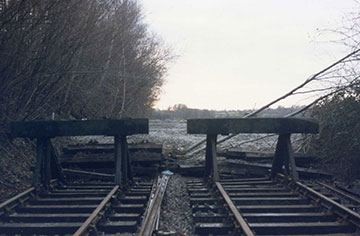
I fully agree that the Uckfield – Lewes link should be reinstated. It should never have been closed in the first place. The arguments which will be made against it becoming BML 2 will be the many sections of single track especially through Cowden tunnel which was singled many years back to allow use of full size rolling stock. Narrower bodied stock had been used because of the restricted width in the tunnel. Would this be left as a single line or would the existing Uckfield London train service be disrupted for an extensive period while the tunnel is enlarged?
John Crowhurst
LikeLike
1. Narrow bodied stock
was required on the Hastings line and therefore on the Tonbridge Eridge line, but not on the Uckfield Oxted service. The line at Cowden etc and thought the tunnel there was singled just to save money.
2. Two of the Main reasons for the Uckfield Lewes closure were the expenditure that was to be required on providing a crossing of the new Lewes bypass road which was about to be constructed, and also the expense of repairs to the poor structural condition of Cliffe high street bridge on the approach to Lewes which was finally condemned 3 months or so before the official final closure came.
LikeLike
I believe that part of the DfT’s reluctance towards BML2 is that any extra train services feeding into East Croydon would bring that station to its knees . . . it is nowadays the case that any minor perturbation there delays services markedly . . . on Monday morning there was a signal failure around Oxted that closed the East Grinstead branch, and my train to Lewes was on time at Clapham Junction and 20 minutes late at Lewes.
I understand that there “was” a proposal to add two extra platforms at East Croydon, but I recall that was to happen in around 2023 . . . it’s all gone very quiet! Perhaps if that happens, BML2 might have a chance?? To be fair, though . . . the countryside south of Uckfield is lovely, but a bit “thin” on chimneys . . . and spending money on what is seemingly a diversionary route for BML1 probably doesn’t stack up well on the DfT value-o-meter. Nice to have, but . . .
Good luck with the makeover !!
greenline727
LikeLiked by 1 person
I suspect the reason that BML2 hasn’t got traction is because it lacks coherence as a proposal. Rebuilding the line between Uckfield and Lewes to provide an alternative through route avoiding Gatwick seems on a par with the crayonista calls to rebuild the line between Okehampton and Plymouth to use as an alternative to the line through Dawlish. By avoiding all the major destinations on the main line (Gatwick, Three Bridges for Crawley, Haywards Heath) you are still going to have massive logistics needed to get people to/from those places in the event of any closure of the line so the gains from being able to divert main line trains is smaller. And it will be a less attractive route for through passengers, being slower than the existing route as well as missing out all those key destinations. The potential value from the line is providing local links from Uckfield and Crowborough to Lewes, but would the train make a significantly better offer than the bus, which currently runs every half hour and extends through to Brighton in one direction and Tunbridge Wells in the other?
LikeLiked by 1 person
The better BML2 option might be the Arundel Curve linking westbound Coastway trains with the Arun Valley line. More a diversionary route, but with options via Three Bridges or Dorking, and no reversal at Littlehampton?
LikeLiked by 2 people
There is also a Railfuture campaign to reopen the Uckfield-Lewes section – details here:
https://www.railfuture.org.uk/Uckfield-Lewes#:~:text=Railfuture%20is%20campaigning%20for%20reinstatement,the%20employment%20centre%20of%20Brighton.
LikeLike
The economics of that link look to be very poor. It is more a nice to have than a sound business case. Any figure that are given tend to understate costs considerably as well, As a rough rule of thumb at least double the costs
Remembers as well passenger numbers have gone down
As for HS2 I do not understand the need to rebuild Euston. HS2 will serve the new rail hub at Old Oak Common .
For most rail passenger coming into Euston it is not there final destination they will carry on here journey on the underground so the Hub would meet most passengers needs
The Old Oak Common Hub will have 14 platforms and serve the following lines
HS2
Elizabeth Line
WCML
GWR
North London Line
West London Line
Chilton Railways
Central Line
There were proposals to link it to the Southern but I dont think that is currently going to happen
LikeLike
Old Oak Common was planned as a through station, which means it doesn’t have enough platforms to act as a permanent terminus for HS2. Not to mention the abject stupidity of running a high speed train to somewhere near London and then making passengers change into lines that are already crowded to actually get to London. Sure, not all of the 400 passengers are going to/from central London, but a good proportion are, and going for the Ryanair model of cutting costs by taking them nowhere near where they want to go is the antithesis of a premium high speed rail model.
OOC as the terminus for HS2 is the ultimate sabotage, the final act of vandalism, intended to destroy any ability for the network to meet any of its objectives, on purely ideological grounds to justify cancelling public investment in rail infrastructure, because they can then use the carefully engineered “failure” of HS2 as a case study.
LikeLiked by 1 person
The main reason for the Old Oak Common Hub is to serve
HS2
If you want to get to Central London the Old Oak Common Hub is ideal in that you have a direct connection to the Elizabeth and Central lines which means you can reach central London quicker and easier than travelling into Euston
Old Oak Common also makes it a lot quicker and Easier to reach Heathrow as well as having easier access to GWR trains
LikeLike
I’m not saying that OOC isn’t a valuable station to have on the route, but its completely inadequate as the main terminus station. Changing to the Elizabeth Line (which is already approaching capacity and would struggle to accommodate any significant number of passengers changing from HS2) to get to central London is far less convenient than staying on a train that would take you straight there.
LikeLiked by 1 person
But Euston is not Central London
LikeLike
Old Oak Common isn’t either, Bob
Shoving everyone onto Elizabeth Line trains simply isn’t workable, end of.
LikeLiked by 1 person
Thanks for this report. Very interesting and well though out!
But your suggestion that we must keep investing in our railways may not necessarily be wise.
As far as I am aware, the railway system currently receives an annual subsidy of about £6 Billion and carries about 2% of overall trips. It is a very expensive system to operate and this is reflected in the very high cost of fares compared to the use of other forms of transport.
So why should we the taxpayers throw more money into railway expansion and operation? I am still horrified by the probable £150 Billion that HS2 is predicted to cost to complete, when that huge amount of money could be better spent on new schools and hospitals!
LikeLike
I find it strange that they keep opening stations where the only way to get to them is by car and they build a huge car park for them
I think it should be a requirement that any new station has a regular bus service wit a minimum frequency of 15 minutes and that proper shelter and Realtime information is provided. Car parks at the station should be for disabled only
LikeLike
Now look at the subsidy for roads…
Part of the reason rail fares are high is our failed privatisation model leading to vast profits being leeched out of the system, and part is because the system is grossly under-capacity and so high fares have to be used to reduce demand down to a manageable level.
LikeLiked by 1 person
I’m bored by these anti-HS2 arguments that have been debunked time and time again. I’d like to see where your figures have come from, given that they’re unrealistically low and the argument doesn’t justify cutting the funding from investing in the railways. Plus I know it’s you, Alan O’Connor.
LikeLike
I guess Alan had to move on from his repeated complaining about bus timetables or somesuch.
Then again, he likely wouldn’t have anything to occupy his time if it wasn’t for half-baked nonsense that he can complain about on here.
LikeLiked by 1 person
I note that you are having site engineering works on Sunday – will there be a substitute bus service?!
MotCO
LikeLiked by 1 person
Replying to StevieinSelby (first comment) – I haven’t got my 1955 ABC, but Ithink the rail journey Uckfield-Lewes used to be around 15 minutes (by steam train). The bus journey is 23 minutes (calling at Isfield – like the train) – but I’m sure that an express bus could do it in 15 mins. A train would call at Lewes station (better for rail connections, not so good for shopping and bus connections). An express bus could call at Lewes centre and station – and it could happen now, rather than after years. Why it isn’t happening already – maybe Roger knows …
LikeLike
Given how spread out Uckfield is, and how much closer most residents are to a stop on the 29 bus than to the railway station, any small time saving the train could offer station-to-station could easily be offset by the longer home-to-station time.
LikeLike
(and likewise Crowborough, where the station is 1½ miles from the town centre)
LikeLike
The problem with even the cut down version of this scheme is the you’re looking at the best part of quarter of a billion pounds to serve a corridor which has an increasingly good bus service that provides a better range of links. If you’ve got that kind of money to throw around on rail in the south east then spend it on something more useful like Heathrow Western Access or the West London proposal. As for the wider BML proposal (if it can seriously be called a proposal) it’s always looked like a crayonist’s day dream, especially the multi billion pound line to the Docklands.
LikeLiked by 2 people
Originally the GWR electrification included a rail link from Reading to Heathrow but that seems to have got dropped
With the Elizabeth line extended to Reading it should not be to difficult to crease a link to Heathrow. It would provide a mor direct link to Heathrow from the Est Country and South Wales and the cost should not be great. Mainly work around Hayes and Harlington probably a bit of tunnelling work
LikeLike
Many wiser heads than mine on all matters “Railway”, but I do like it that several Commentators mention the excellent 30′ frequency bus service (29) which once more speeds down the main road linking the two town centres in just 20 minutes, leaving the 29A every 60′ to serve Isfield Station and taking a few minutes longer. Of course, the “Toad of Toad Halls” who populate the area would laugh at the notion of hanging up their car keys to use the transport of last resort, but strangely, their children do not. See how many “Chelsea accents” from youngsters you hear on a Saturday in particular when travelling on this popular route.
Of course, and as always in hindsight, the line should never have closed, but it was because it lost a lot of money at the time. And post-Covid, the whole landscape and use of the railway has changed. All improvements and new stations are to be welcomed with open arms, but whole line re-building in a deeply rural areas would probably not bring in the benefits that existed four years ago.
Terence Uden
LikeLike
If you want an even shorter project that would provide many benefits, have a look at the attempts to reinstate one or both of the two Burscough curves, situated between Wigan, Southport, Preston and Ormskirk.
LikeLike
This post reminded me of a treasured book of mine detailing the electrification of the Southern Railway. Its a fascinating read so I’ve added a link in case anyone is interested.
Peter Brown
https://www.pen-and-sword.co.uk/Alfred-Raworths-Electric-Southern-Railway-Hardback/p/20513
LikeLiked by 1 person
UNO’s new timetables have appeared which give a good idea why they didn’t want to be messing around with the 84B (from the previous blog).
The 610 goes half hourly which another two buses’ work and the new X10 is either three of four buses (depending on whether its interworked with the 610). That makes a bus every 15 minutes between Luton and Hatfield up from the previous hourly service.
Their TfL school service commitments are also dramatically expanding with the 628, 643, 653 and 688 being taken over (I think).
LikeLike
It appears UNO may be getting some electric buses. There were originally going to go to Arriva Stevenage but they pulled out of the scheme
LikeLike
All this is good stuff in the long term but meanwhile what is happening now ? Crowborough has new lifts but in the process they cut up the historic cast iron footbridge (why couldn’t it have gone to a preserved railway ?) and Southern still haven’t restored the 2207 departure from London Bridge resulting in a two hour gap in the late evening . How many other lines have this poor level of service and how is Southern allowed to get away with it ? As for the 29 fine if you live in the centre but it doesn’t serve Jarvis Brook where the station is located. As Roger pointed out in a previous blog the bus service here has got worse with the withdrawal of the Compass service to Tunbridge Wells. The best service on the line has ironically been on strike days with a shuttle service to Oxted. Why don’t Southern run a reliable Oxted shuttle daily with just peak and late evening trains to London Bridge. That would reduce diesel emissions too. The current service pattern on the Uckfield line is unreliable. Oxted offers a choice of destinations and good interchange but often trains don’t connect. Is there someone out there who actually cares ?
LikeLike
That bridge unfortunately probably wasn’t saveable. There’s a worrying amount of ironwork on today’s railway which is little more than rust held together with layers of paint, and since a lot of expertise was given the push by Railtrack who basically hated old-BR-know-alls, a lot of it may not be being properly monitored or even if it is then the reports are being brushed aside at higher levels as unimportant – see lots of RAIB accident investigation reports passim.
LikeLike
Whilst the Uckfield to Lewes is very worthy the add on bits of BML2 do not make sense. I pointed out in the local newspaper many years ago that the proposal to bolt on Eridge to Tunbridge Wells would firstly obliterate the Spa Valley Railway and secondly the major obstacle of the Sainsbury’s store built right across the track bed. Brian Hart of the Wealden Line Campaign very aggressively replied that Sainsbury’s would have to emove part of their store if asked and that I obviously just wanted to play steam trains.
I lost interest in their campaign at that point as obviously didn’t want to accept that others may not want to roll over to accept their plans.
Paul Gander
LikeLiked by 1 person
The problem with the whole BML2 project is that the simple Uckfield to Lewes link isn’t financially sustainable (and you can pretty much triple that 2008 number dreamed up by Network Rail). To counter this, the group have come up with various add-ons which certainly provide more benefits, but at even more unsustainable costs. I do wonder what their next extension (look: even more benefits!) might be.
Paul B
LikeLiked by 1 person
A big problem with tail is the crazy cost and the lengthy time scales even a simple basis stations costs tens of millions and takes several years. Add in the cost ad timescale overruns
LikeLike
The challenge with Lewes to Uckfield, Skipton to Colne, the withered arm and some of the other schemes being put forward providing an alternative route is that the business case benefits for diversion and redundancy for a transport route is really poor. The main route actually serving places has been kept in place.
In addition, it’s not just the cost of restoring the missing section, there is the cost of upgrading the lines at either end, noting that the services using the restored railway line might create further capacity constraints on the network as their bottlenecks have to be factored in.
Ashington and Okehampton were winners for funding because the railway line is there and the there is capacity entering Newcastle and Exeter.
LikeLiked by 1 person
There’s also a Railfuture campaign to restore this missing link – details here: https://www.railfuture.org.uk/Uckfield-Lewes#:~:text=Railfuture%20is%20campaigning%20for%20reinstatement,the%20employment%20centre%20of%20Brighton.
LikeLike
Connex (remember them?) ran a bus service between Uckfield and Lewes via Ringmer with through fares from some of their other stations, but it had been discontinued by the time GoVia took over the franchise in 2001.
Steven Saunders
LikeLiked by 1 person
Connex (SE) also ran a very useful coach link between Ashford & Calais via the Channel Tunnel for a while, but unfortunately it was sabotaged by Eurotunnel who refused to reserve space on their shuttles for a scheduled service and treated it very much as a nuisance – on one occasion when I used it three coaches were on the same France-bound shuttle, on what was advertised as an hourly service meaning some poor souls would have been stood in Calais for three hours when our three-coach convoy eventually arrived.
Had it been allowed to be reliable, it would have been far more successful than most DRT schemes ever are!
LikeLiked by 2 people
Frankly, Roger’s comments – and those of the campaign groups – are way out of line with economic and social reality. Roads, despite an unstated almost ideological dislike / disapproval of them in some very influential circles, provide the core transport needs of the country with rail important in only in a few markets, such as London commuting. While a full train between two points is going to be much better for emissions than a single car (the go to comparison), empty 12 car off peak trains rattling through the countryside during off peak periods, which is a common occurrence on this type of line, are not very environmentally friendly either. The vast majority of journeys except for commuting, and some journeys between city centres, are not of patterns that rail can easily serve. Despite the justifications trotted out like mantras, were this line reopened, it is likely that there would be an imperceptible effect on local road traffic levels. But rail is intrinsically virtuous and road not, it seems. It is true that new roads also cost a lot of money to build, but then don’t subsequently, unlike rail, also generate ongoing high operating costs, including the salaries of large numbers of operational, revenue (and office) staff. They also tend to be just much more intensively used, despite the much greater potential carrying capacity of a single train.
Sometimes, to hear rail pressure groups, you sometimes wonder why these wonderfully useful lines were ever closed in the first place! That they were losing vast sums of money was the reason, and not enough people using them. Beeching got most of his calls right, despite the obloquy routinely heaped on him. Many people objecting to rail closures liked the idea of trains chuffing along in the background, and perhaps for use as an emergency backup, rather than were ever going to use them on a day to day basis. Many railway stations were not situated in the towns they purported to serve, and even before the dominance of the private car (not a conspiracy, people liked owning and using cars!), buses often provided a better alternative. (How on Earth, I wonder, did the nearby Bluebell Railway ever get built in the first place?!). Closure wasn’t often popular – governments would prefer to be popular if they could – so on that basis alone the policy must have had strong justification.
Sure, we could have increased subsidies, but this would be in competition with health, education, defence and all the other calls on government spending. This country, by the way, is in a terrible economic mess, and the endless calls by pressure groups for their own favoured spending when both government spending and taxation are already at historically high levels amount to living in an economic fantasy world.
Even in terms of purely transport investment, would reopening Uckfield to Lewes – which has no intermediate towns at all and few villages and a tiny rural population – even perform well as a project compared to much potentially busier areas? There is a pretty good interurban bus service in this corridor, which unlike the railway links to a major hub, Tunbridge Wells. Yes, potentially the line would be useful as an alternative route when the direct Brighton line is closed, although the rail replacement services by bus to Three Bridges is performed efficiently in my experience, and I am not sure the via Uckfield route would be that much faster. Not having to change would be an advantage, but can a very expensive piece of effectively new railway (and some completely new alignment) be justified on that occasional basis? Direct trains, which do not have to reverse, cannot serve both Brighton and the Eastbourne / Hastings direction, unless two such linking tunnels were constructed!
Having said all this, I like railways as much as anyone, and I would like to see the line reopened if it could be, and indeed might occasionally even use it!. (Although realistically by the time it could be reopened I might already be too old! But we can’t (or shouldn’t) justify the investment of limited public funds on that basis!
I do apologise that this comment has been so lengthy, but I do feel the enthusiasts have to sometimes be brought to face up to reality.
LikeLiked by 2 people
Cars and road traffic generally are subsidised because society as a whole pays for their externalities. So I as a car free person have to breathe all the rubbish car drivers pollute my air with and get zero compensation for it. Cars should be made to pay for pollution, congestion and the cost of road traffic accidents which still account for significantly mortality and injury often to completely innocent people. This would level up the playing field. With the true cost of motoring up front bus and train fares would be very competitive. Also the central government spends an estimated £192 000 per mile on maintenance of M and A roads. Not insignificant.
LikeLiked by 1 person
Uckfield and Lewis are both small towns and located a fair way from the old stations by the time you have driven to the station and got a train you might as well drive all the way
The line was built before the days of the car and when there was a lot of freight and holiday traffic which no longer really exists
The business case for it is hopeless
LikeLiked by 1 person